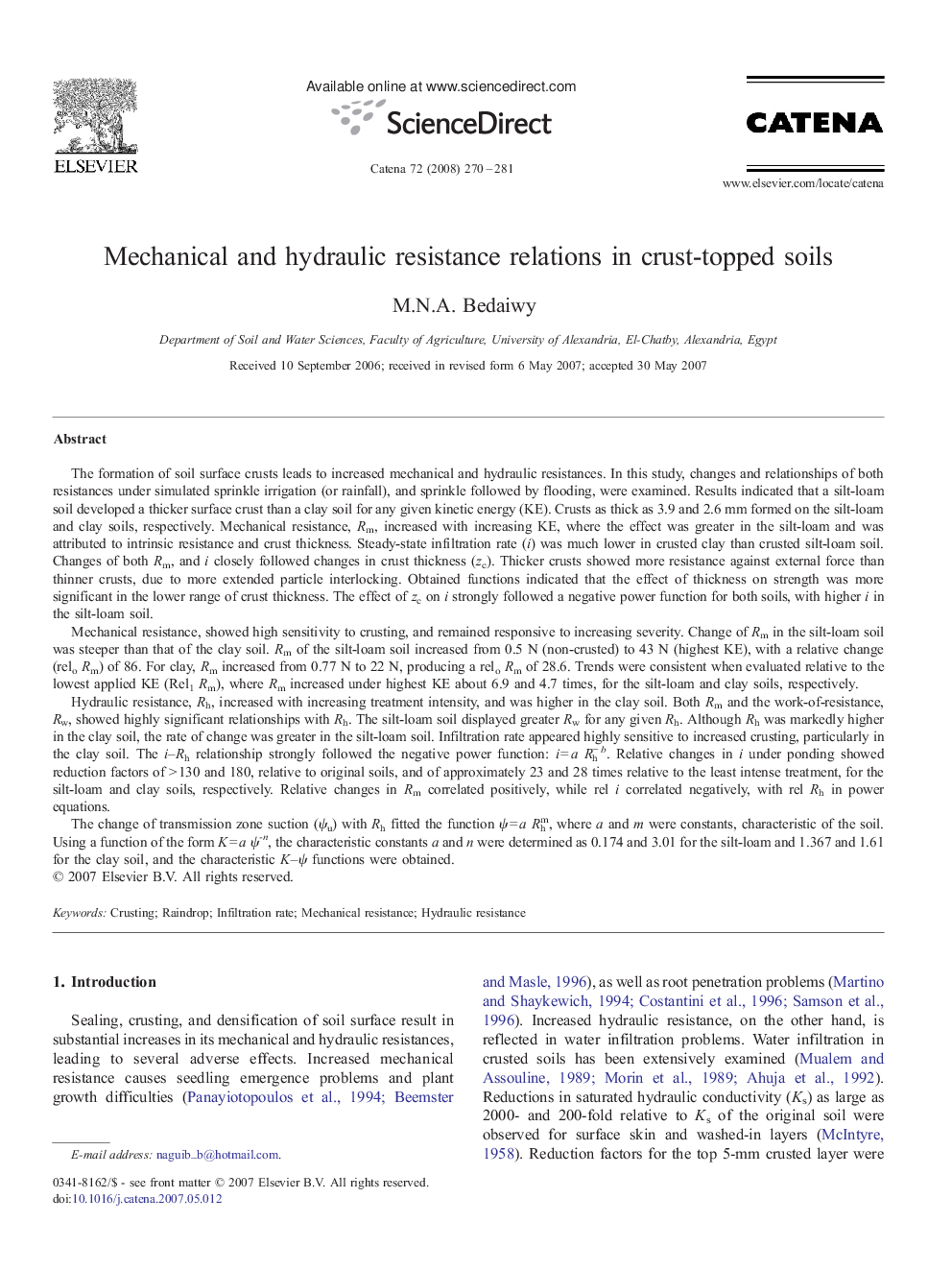| کد مقاله | کد نشریه | سال انتشار | مقاله انگلیسی | نسخه تمام متن |
|---|---|---|---|---|
| 4572537 | 1332183 | 2008 | 12 صفحه PDF | دانلود رایگان |

The formation of soil surface crusts leads to increased mechanical and hydraulic resistances. In this study, changes and relationships of both resistances under simulated sprinkle irrigation (or rainfall), and sprinkle followed by flooding, were examined. Results indicated that a silt-loam soil developed a thicker surface crust than a clay soil for any given kinetic energy (KE). Crusts as thick as 3.9 and 2.6 mm formed on the silt-loam and clay soils, respectively. Mechanical resistance, Rm, increased with increasing KE, where the effect was greater in the silt-loam and was attributed to intrinsic resistance and crust thickness. Steady-state infiltration rate (i) was much lower in crusted clay than crusted silt-loam soil. Changes of both Rm, and i closely followed changes in crust thickness (zc). Thicker crusts showed more resistance against external force than thinner crusts, due to more extended particle interlocking. Obtained functions indicated that the effect of thickness on strength was more significant in the lower range of crust thickness. The effect of zc on i strongly followed a negative power function for both soils, with higher i in the silt-loam soil.Mechanical resistance, showed high sensitivity to crusting, and remained responsive to increasing severity. Change of Rm in the silt-loam soil was steeper than that of the clay soil. Rm of the silt-loam soil increased from 0.5 N (non-crusted) to 43 N (highest KE), with a relative change (reloRm) of 86. For clay, Rm increased from 0.77 N to 22 N, producing a reloRm of 28.6. Trends were consistent when evaluated relative to the lowest applied KE (Rel1Rm), where Rm increased under highest KE about 6.9 and 4.7 times, for the silt-loam and clay soils, respectively.Hydraulic resistance, Rh, increased with increasing treatment intensity, and was higher in the clay soil. Both Rm and the work-of-resistance, Rw, showed highly significant relationships with Rh. The silt-loam soil displayed greater Rw for any given Rh. Although Rh was markedly higher in the clay soil, the rate of change was greater in the silt-loam soil. Infiltration rate appeared highly sensitive to increased crusting, particularly in the clay soil. The i–Rh relationship strongly followed the negative power function: i = a Rh− b. Relative changes in i under ponding showed reduction factors of > 130 and 180, relative to original soils, and of approximately 23 and 28 times relative to the least intense treatment, for the silt-loam and clay soils, respectively. Relative changes in Rm correlated positively, while rel i correlated negatively, with rel Rh in power equations.The change of transmission zone suction (ψu) with Rh fitted the function ψ = a Rhm, where a and m were constants, characteristic of the soil. Using a function of the form K = a ψ-n, the characteristic constants a and n were determined as 0.174 and 3.01 for the silt-loam and 1.367 and 1.61 for the clay soil, and the characteristic K–ψ functions were obtained.
Journal: CATENA - Volume 72, Issue 2, 15 January 2008, Pages 270–281